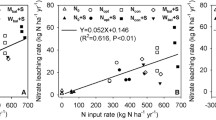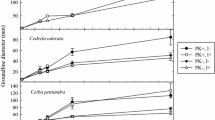Abstract
Improved or planted fallows using fast-growing leguminous trees are capable of accumulating large amounts of N through biological N2-fixation and subsoil N capture. During the fallow phase, the cycling of nutrients is largely efficient. However, there are few estimates of the fate of added N during the cropping phase, after the 'safety net' of fallow-tree roots is removed. Nitrate-N at the end of the fallow phase, which is pre-season to the subsequent crop, was monitored in seven land use systems in successive 20-cm soil layers to 120 cm depth at Domboshawa, Zimbabwe in October 2000. Thereafter, nitrate-N dynamics was monitored during cropping phase until April 2001 at 2-week intervals in plots that had previously 2-year planted fallows of Acacia angustissima and Sesbania sesban, and in a continuous maize control. Pre-season nitrate concentrations below 60 cm soil depth were <3 kg N ha−1 layer−1 for S. sesban, A. angustissima, Cajanus cajan and natural woodland compared with the maize (Zea mays L.) control, which had >10 kg N ha−1 layer−1. There was a flush of nitrate in the S. sesbania and A. angustissima plots with the first rains. Topsoil nitrate had increased to >29 kg N ha−1 by the time of establishing the maize crop. This increase in nitrate in the topsoil was not sustained as concentrations decreased rapidly due to leaching. Nitrate then accumulated below 40 cm, early in the season when maize root length density was still low (<0.1 cm cm−3) and inadequate to effectively intercept the nitrate. It is concluded that under light soil and high rainfall conditions, there is an inherent problem in managing nitrate originating from mineralization of organic materials as it accumulates at the beginning of the season, well ahead of peak demand by crops, and is susceptible to leaching before the crop root system develops.
Similar content being viewed by others
References
Birch H.F. 1964. Mineralization of plant nitrogen following alternative wet and dry conditions. Plant and Soil 20: 43–49.
Buresh R.J. and Tian G. 1997. Soil improvement by trees in sub-Saharan Africa. Agroforestry Systems 38: 51–76.
Giller K.E., Cadish G., Ehaliotis C., Adams E., Sakala W.D. and Mafongoya P.L. 1997. Building soil nitrogen capital in Africa. In: Buresh R.J., Sanchez P.A. and Calhoun F. (eds.), Replenishing Soil Fertility in Africa. SSSA Special Publication Number 51. Soil Science Society of America, Madison, WI, USA, pp. 151–192.
Hartemink A.E, Buresh R.J., Jama, B. and Janssen, B.H. 1996. Soil nitrate and water dynamics in Sesbania fallow, weed fallows, and maize. Soil Science Society of America Journal 60: 568–574.
Kamukondiwa W. and Bergstrom L. 1994. Nitrate leaching in field lysimeters at an agricultural site in Zimbabwe. Soil Use and Management 10: 118–124.
Keeney D.R. and Nelson D.W. 1982. Nitrogen-inorganic forms. In: Page A.L., Miller R.H. and Keeny D.R. (eds.), Methods of Soil Analysis. Agronomy Monograph 9, Second edition, American Society of Agronomy, Madison, WI, USA, pp. 643–698.
Kwesiga F. and Coe R. 1994. The effect of short rotation Sesbania sesban planted fallows on maize yield. Forest Ecology and Management 64: 199–208.
Mafongoya P.L. and Nair P.K.R. 1997. Multipurpose tree prunnings as a source of nitrogen to maize under semiarid conditions in Zi-mbabwe. 1. Nitrogen recovery rates in relation to pruning quality and method of application. Agroforestry Systems 35: 31–46.
Mafongoya P.L., Dzowela H.B. and Nair P.K.R. 1997 Effect of multipurpose trees, age of cutting and drying method on pruning quality. In: Cadish G and Giller K.E. (eds.), Driven by Nature: Plant Litter Quality and Decomposition. CAB International, Wallingford, UK, pp. 167–174.
Mekonnen K., Buresh R.J. and Jama B. 1997. Root and inorganic nitrogen distributions in Sesbania fallow, natural fallow and maize fields. Plant and Soil 188: 319–327.
Nair P.K.R. 1993. Introduction to Agroforestry. Kluwer, Dordrecht, The Netherlands, 499 pp.
Newman E.I. 1966. A method for estimating the total length of roots in a sample. Journal of Applied Ecology 3: 139–145.
Palm C.A. 1995. Contribution of agroforestry trees to the nutrient requirements of intercropped plants. Agroforestry Systems 30: 105–124.
Read M.D., Kang B.T. and Wilson G.F. 1985. Use of Leucaena leucocephala leaves as a source of nitrogen for crop production. Fertilizer Research 8: 107–116.
Schroth G. 1995. Tree root characteristics as criteria for species selection and systems design in agroforestry. Agroforestry Systems 30: 125–143.
Tennant D. 1975. A test of a modified line intercept method of estimating root length. Journal of Ecology 63: 993–1001.
van Noordwijk M. 1989. Rooting depth in cropping systems in the humid tropics in relation to nutrient use efficiency. In: van der Heide (ed.), Nutrient Management for Food Crop Production in Tropical Farming Systems. Institute of Soil Fertility, Haren, The Netherlands, pp. 129–144.
van Noordwijk M., Lawson G., Soumare A., Groot J.J.R. and Hairiah K. 1996. Root distribution of trees and crops: competition and/or complementarity. In: Ong C.K. and Huxley P. (eds.), Tree-Crop Interactions: A Physiological Approach. CAB International, Wallingford, UK, pp. 319–364.
Author information
Authors and Affiliations
Corresponding author
Rights and permissions
About this article
Cite this article
Chikowo, R., Mapfumo, P., Nyamugafata, P. et al. Nitrate-N dynamics following improved fallows and maize root development in a Zimbabwean sandy clay loam. Agroforestry Systems 59, 187–195 (2003). https://doi.org/10.1023/B:AGFO.0000005219.07409.a0
Issue Date:
DOI: https://doi.org/10.1023/B:AGFO.0000005219.07409.a0




